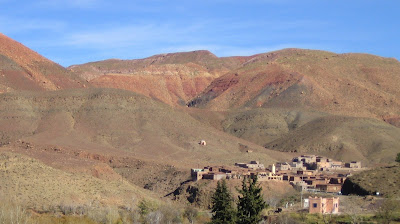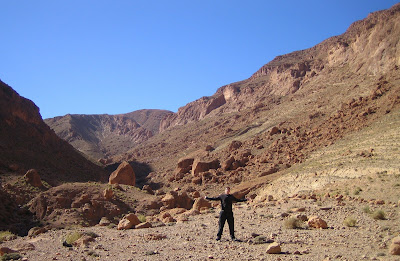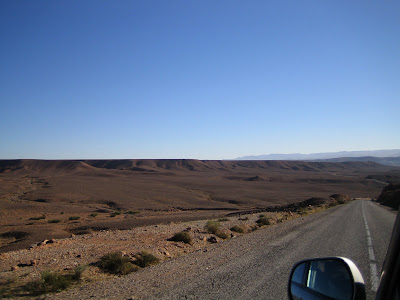
Back in 2007 Dingo and I climbed Morocco’s highest mountain (
www.walter82.blogspot.com/2008/03/morocco.html). I only spent six days in the country split between the hills and Marrakech. Expectant though I was, the country intrigued me and the landscape excited me. Another trip had to be on the agenda… So for the turn of the decade Ramsay, Bassett and I escaped the snow of England for the almost, at times, T-shirt weather of Moroccan winter an adventure with Aziz!
My body was thoroughly confused when I shuffled off the plane, in and out of a bus and on to the streets of Marrakech. In a few days I had travelled from Brazil, back to Blighty and now to North Africa. A lack of sleep did not aid the situation. This is the context for my return to Djemaa el Fna, the buzzing central square of the city.

It had lost none of its charm. Despite, or perhaps because of my confused and drained mental state, I was perplexed with wonder at the scene that unfolds as the sun sets and the city comes to live. From one of the old French cafes overlooking the Djemma el Fna we were spoilt by a scene of shops, stalls, sellers, buyers and minglers. Athletic dancers, snake charmers and monkey men shrouded in the smoke from a hundred kitchens coming to light and the crowds of onlookers and avoiders. A wonderful scene set off by the most exquisite sunset, the light at once softening and shifting to greater radiance of red and golden hue. A jaw-dropping scene flanked by the snow-capped Atlas and pervaded by a multi-layered call to prayer, ringing out from many a minaret.
Out over the hills…The next morning we tucked into a good breakfast and met up with Aziz, our driver "Bob" and the 4x4 that was to take us into the south. I was so glad to be meeting up with Aziz again after our adventures a couple of years before. A man of such kindness and strength.
Out of the big city and towards the Atlas, we made a pit stop at a large local market.

Split into sections for dead animals, live animals, vegetables, cooked food, carpentry, bric-brak and so on. Having spent 5 months in sub-saharan Africa the previous year, Dave drew stark contrast with equivalent markets below the Sahara. Here there was so much more variety and local product. An example of why North Africa fits more naturally into a mixture of Middle Eastern and Mediterranean spheres then those of its neighbours to the South. I for one was taken aback by the level of workmanship, productivity and sheer scale of this market. We walked for nearly an hour and never covered the same ground or produce once. As is the way in this land, we had time to mull it all over a round of local tea (for the third time in the day and it was not even lunch!).
From there we crossed the remainder of the Marrakech plain before the back and forth of the ascending mountain roads.
The Return of the AtlasDry and stark, buy with life clinging all around, it is a privilege to drive through this Berber heartland. It is amazing to see how Aziz, himself a Berber, knows and greets so many people in the villages, other cars and on the road. A social society where bonds of family and friendship are of great importance.

As Ramsay and I get deep into discussions about his current time in the army and the consequences of a hierarchical life/organisation, we drive past one spectacular view after another. The scenery does not holdback. Speeding along roads cutting, at times precipitously, across the piste of mountain after mountain.

At length these mountains are broken by hills and we see the claws of the Sahara opening up before us. A view that salivates in the hunger for adventure.
Ait BenhaddouAll the talk had been of deserts and treks, so I was not expecting what lay at the end of a few kms off road. Ait Benhaddou bowled me over side ways and then came back for a second bight. Simply world class.

In the middle of a buffeted sand-strewn landscape rises a high point brandishing this mighty sandstone Kasbah (fortified city). Used in many a film from Gladiator to Lawrence of Arabia, it is spectacular in the shifting African sun. Sand and ever moving shadow.

Up close you see small etched detail slowly giving way to the erosion of the wind and rare rains. We, of course, stopped for tea in one of the remaining habited buildings. Goats and sheep in one room, us in the other, as the mother of the house dished out delicious sweet tea. Her hands were covered in intricate henna and, despite practice, we were a long way off successfully imitating her measured tea-pouring style – low down and then slowly up as you begin to pour, reaching a crescendo an arms length above the cup and then back down with a flick up of the wrist and flourish.
With this enchanting place still rattling around our thoughts we settled in for the night at the city of Ouarzazate.
Todra Gorge and Fossils GaloreWe awoke to another long journey across the semi-desert which flanks the Southern edge of the Atlas. By the time we reached the lush oasis of the Todra valley and drove up towards the famed gorge I was itching to stretch my legs.

The landscape round here is really something. Stark yellow’s all around, divided by the green of the valley which narrows as it approaches the hills. From abounding palm trees, this wedge effect eventually squeezes out all shrubbery as the hills rise starkly on each side. Up and up until vertical cliffs run hundreds of metres high on either side of a 15m wide pass.

It reminded me of Petra, though at the other end of the gorge, instead of a plethora of ancient buildings, there are rocks for scrambling up to some fantastic views of the real rock climbers hanging on for dear life (the gorge is a bit of magnet for people of a clinging persuasion).

Back in the car across arid Southern Morocco we rode on. The only pit-stop to the dunes a remarkable fossil workshop. The myriad of rock formations and folds in this part of the world have thrown up huge quantities of fossils.

Here work concentrated on those of sea-creatures originating from a body of water long since transformed into this waterless place. To run your hands over a two hundred million year old fossilised ammonite as big as you head is quite a thrill. The workmanship was, as seems often the case in Morocco, of a very high quality, producing everything from tables, to ear-rings and the kitchen sink (literally).

On and on until as the sun waned, we caught our first sight of the dunes. At first a faint bobbling, then undeniable. We had made it to Erg Chebbi and would spend the night amongst the Saharan mountains of sand…
 Here work concentrated on those of sea-creatures originating from a body of water long since transformed into this waterless place. To run your hands over a two hundred million year old fossilised ammonite as big as you head is quite a thrill. The workmanship was, as seems often the case in Morocco, of a very high quality, producing everything from tables, to ear-rings and the kitchen sink (literally).
Here work concentrated on those of sea-creatures originating from a body of water long since transformed into this waterless place. To run your hands over a two hundred million year old fossilised ammonite as big as you head is quite a thrill. The workmanship was, as seems often the case in Morocco, of a very high quality, producing everything from tables, to ear-rings and the kitchen sink (literally).
No comments:
Post a Comment